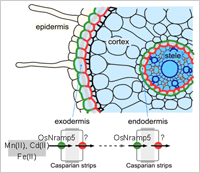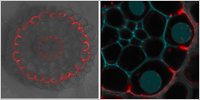Identification of a rice transporter for manganese and cadmium uptake
Rice (Oryza sativa) is an important dietary source of cadmium and can accumulate very high levels of manganese without toxic effects. However so far there has been little understanding of the uptake and transport mechanisms for these minerals. In depth studies by Jian Feng Ma and colleagues at Okayama University in Japan have revealed how OsNramp5, a member of the natural resistance macrophage protein (Nramp) family, enables uptake of specific minerals in rice.
The researchers performed a number of investigations to compare wild-type rice plants with plants that had an insertion in the gene (knockout line) from the Rice Mutant Database. The mutant line had a grain yield of only 11% that of the wild-type rice. High-manganese concentrations conditions partially restored the growth of Nramp5 knockout mutant rice. The impaired growth was attributed to lack of manganese uptake in mutant rice.
Cadmium is not essential for plant growth so it is likely to use other metal ion transporters rather than having a specifically evolved uptake route. The results reported by Ma and colleagues suggest that OsNramp5 provides a route for cadmium uptake from the soil as well. As the authors point out, "manipulating the selectivity of this transporter will be important for regulating Cd transfer from the soil to the grain in the future."
Reference:
・ Authors: Akimasa Sasaki, Naoki Yamaji, Kengo Yokosho, and Jian Feng Ma
・ Title of original paper: Nramp5 Is a major transporter responsible for manganese
and cadmium uptake in rice
・ Journal, volume, pages and year: The Plant Cell 24, 2155-2167 (2012).
・ Digital Object Identifier (DOI): 10.1105/tpc.112.096925
・ Affiliations: Institute of Plant Science and Resources, Okayama University, Kurashiki 710-0046, Japan


